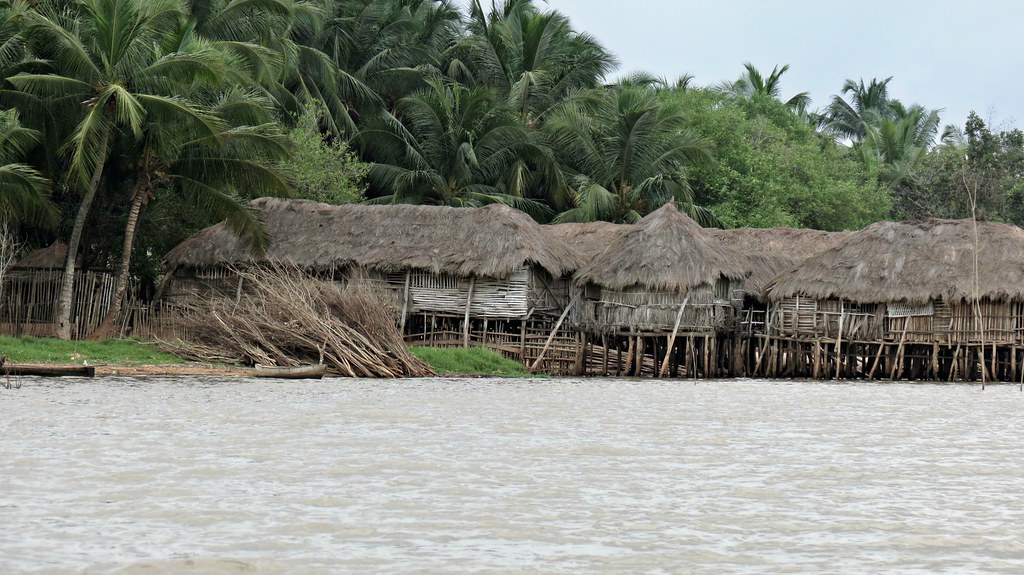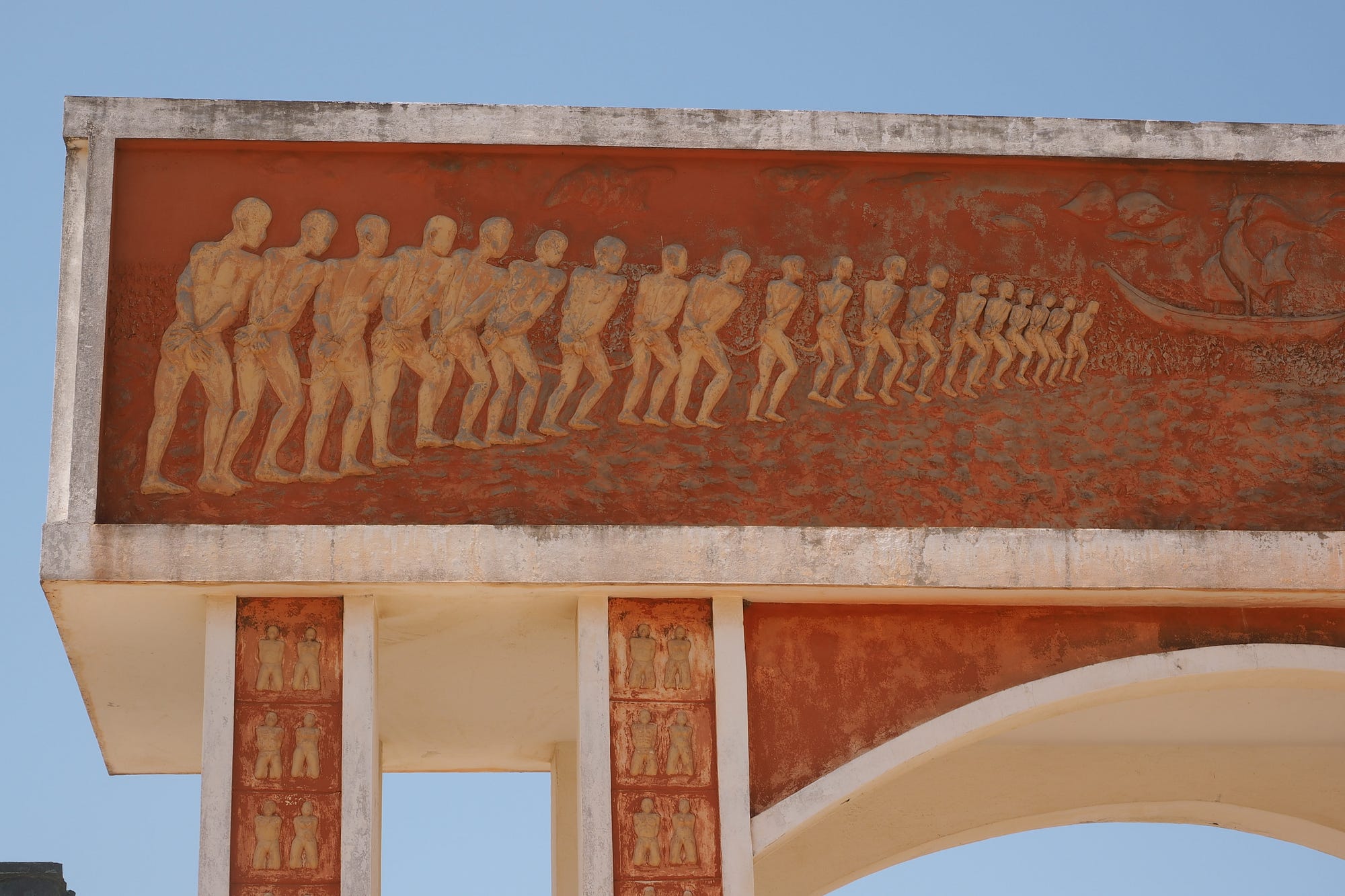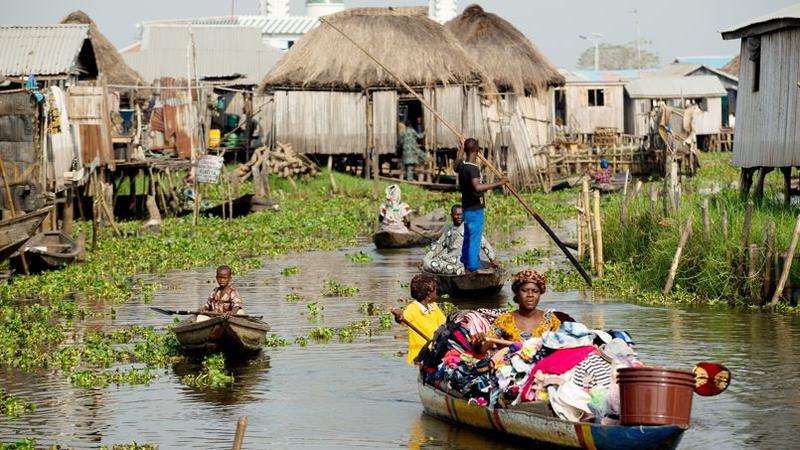Benin February 2-5, 2017
Togo/Benin border. This was a relatively painless crossing at Hilakondji taking about an hour. As usual, the immigration officials on the Benin side put their stamps on a fresh passport page. Steve seems very resistant to request they stamp pages with stamps on them. This is of little concern to me as I will have enough pages to finish this trip (and then get a new passport when home), but is of real concern to those with small passports who will need a new passport to continue to Nairobi or Cairo.
On the Benin side, we passed an estimated 200 Dangote Cement semitrailers headed into Togo and waiting to cross along the side of the road. All produce here is sold from elevated stands on the edge of the highway. Every stand has gasoline sold in whiskey bottles filled by siphon from large bulbous glass jars (I didn’t see one traditional petrol station). We passed a large wetland with stick fishing wiers blocking all the channels.
Possotomé & Lake Ahémé. On the north side of the highway was the fertile shores of Lake Ahémé, an interesting place to spend a few days, particularly around Possotomé, the area’s biggest village. It’s possible to swim in the lake. Various trips and excursions are offered to learn traditional fishing techniques, meet craftspeople at work or go on two-hour botanic journey to hear about local plants and their medicinal properties.
We didn’t stop here. The houses were built so close to the water, they actually appeared to overhang the edge.

GRAND POPO (pop 10,000)
We camped at Auberge de Grand Popo, a resort with rooms, restaurant, very shallow pool and a huge camping area in the trees next to the beach. Also there was a Dragoman group, a UK tour company that offers tours in West Africa. With 17 passengers, the overland vehicle was older and smaller than ours with forward-facing seats and luggage storage in a pile at the back. Most were doing a three-week trip that started and ended in Accra. They had a driver/mechanic and tour guide and also camped in tents. This was the first time Steve had ever stayed at the same place as a Dragoman tour.
OUIDAH (pop 87,200)
Some 42km west of Cotonou is Ouidah, a relaxed, relatively prosperous town and a must-see for anyone interested in voodoo or Benin’s history of slavery. From the 17th to the late 19th century, captured countrymen from across West Africa left Ouidah for the Americas. Vodou (voodoo) got its current name in Haiti and Cuba, where the religions arrived with Fon and Ewe slaves from the Dahomey Kingdom and mixed with Catholicism. It means ‘the hidden’ or ‘the mystery’. Traditional priests are consulted for their power to communicate with particular spirits and seek intercession with them. This communication is achieved through spirit possession and ritual that often involves a gift or ‘sacrifice’ of palm wine, chickens or goats.
Voodoo was formally recognised as a religion by the Beninese authorities in February 1996. Since then, 10 January, Voodoo Day, has been a bank holiday, with celebrations all over the country. Those in Ouidah, voodoo’s historic centre, are among the best and most colourful, with endless singing, dancing, beating of drums and drinking.
Getting There & Away. From Carrefour Gbena, north of town, you can catch shared taxis to Cotonou (CFA1000, one hour), Grand Popo (CFA1500, one hour) and the Hilakondji border (CFA1500, 1½ hours).
Route des Esclaves. Once sold, slaves were taken from the fort to the beach down the 4km Rte des Esclaves. Lining the sandy track now are fetishes and monuments, such as the Monument of Repentance and the Tree of Forgetfulness. There is a poignant memorial on the beach, the Point of No Return, with bas-relief depicting slaves in chains. It’s such a beautiful spot that it’s hard to fathom that 12 million people were deported from this very shore.


Musée d’Histoire de Ouidah. Ouidah’s main site is its Musée d’Histoire de Ouidah, housed in the beautiful Fortaleza São João Batista, a Portuguese fort built in 1721. It retraces the town’s slave-trading history and explores the links between Benin, Brazil and the Caribbean.
Python Temple. Those interested in voodoo could visit the python temple, home to some 60 sleepy pythons. The guide explains some of the beliefs and ceremonies associated with the temple. They feed the pythons rats and sacrifice a chicken once per week.
Secret Forest. This patch of trees contains many modern cement statues of various voodoo gods. Some are metal sculptures that seem oddly out of place. In the center is a 400 year old tree. At another tree, one can make a wish for a small donation.
The tour costs 1000 CFA and the guide gives good explanations. But this has little relevance to actual voodoo and I found it a waste of money and time. It is difficult to find as there are no signs showing the way and none of the many locals we asked for directions had a clue about it. Take the east-west street north of the museum and go east until the sign for the Auberge Jardin Secret, turn left (north) and walk for 10-15 minutes. The forest is on the right.
We camped at the “Le Jardin Brésilien Auberge de la Diaspora near the Point of No Return monument. Several got a fan room. Steve refunds the cost of camping making a room a great deal. The resort has several styles of room, many with A/C and a large complex with a great free, salt-water swimming pool with three heights of diving boards. Throughout the night, about 25 workers were placing the tiles in the complex around the pool. I woke up at 3am and watched them for about an hour. About half the crew were young teenagers doing the labour of hauling tiles, water, cement and preparing the base for the tiles.
Voodou Ceremony. We were able to organize a trip into Ouidah to see an actual voodou ceremony. We arrived at about 5 and were seated in a bunch of plastic chairs in the front row. The ceremony was the first night of four days and was supposedly to celebrate the eradication of smallpox. Held at a major intersection down from the temple, it didn’t start until sundown. I invited a 5-year old boy to sit on my lap. His 3 year old sister was frightened and despite his several invitations refused to sit on my lap until I gave her a carmel candy. Both had the typical facial scars of voodou – 8 slashes on their cheeks and forehead. Fronted by 30m of open street, a huge crowd was assembled with a group of 7 musicians playing drums and rattles surrounded by women singers at one end. A man came around and after giving the musicians shots of palm wine (spirit that tasted much like vodka) and then gave most of us a shot too. Initially 6 women, 2 girls and 3 men wearing elaborate bead and cowrie shell necklaces and a cowrie shell headpiece with a red feather circled the musicians. When in front, groups of three did a dance – crouching with aggressive shoulder and arm movements. The grandmother of the kids was one of the older women and they excitedly pointed and said “Grandma” every time she walked by in the circle. Mom stood behind and kept a stern eye on me. After they circled several times, seven priests (6 men and one woman) wearing round, flat-topped hats appeared. Each danced in a progression of oneupmanship with each dance getting more and more aggressive – back flips, somersaults, cartwheels and Russian cartwheels – they were incredibly skilled. One of the male priests and the female priest at one point danced front to front and then doggy style making obvious gestures at sexual intercourse. At one point one did a somersault onto Tammy with his head between her knees.


The head priest approached the guide five times arguing for us to leave and we finally exited early, not knowing if the whole ceremony was over or not. We returned to the square and ate street food, exhilarated by the spectacular ceremony.
COTONOU (pop 890,000)
Cotonou is Benin’s capital in everything but name: a vibrant, bustling, full-on city, and very much the economic engine of Benin with good nightlife, great restaurants and excellent shopping. Five passengers went into Cotonou but most thought it not worth the effort. The seemingly endless Grand Marché du Dantokpa is Cotonou’s throbbing heart, bordered by the lagoon and Blvd St Michel. Everything under the sun can be purchased in its labyrinthine lanes, from fish to soap, plastic sandals to goats, pirated DVDs to spare car parts. More traditional fare, such as batiks and Dutch wax cloth, can be found in the market building. The fetish market section is at the northern end of the larger market.
Fondation Zinsou. This fantastic exhibition space seeks to promote contemporary African art among Beninese people.
Route des Pêches. West of Cotonou, past the airport and all the way to Ouidah, is the sandy Rte des Pêches, a land of seemingly endless beaches and fishing villages, a world away from the big-smoke mayhem.
GANVIÉ
The main attraction near Cotonou (and one of Benin’s highlights) is Ganvié, where 30,000 Tofinu people live in bamboo huts on stilts several kilometres out on Lake Nokoué. They live almost exclusively from fishing.
Despite the fact that the town has become a tourist magnet, it’s a terrific place to explore and sample village life. It’s not a bad idea to overnight in Ganvié to get a better understanding of the environment and traditional life of the community. Tours from Calavi-Kpota in a regular/motorised pirogue include a circuit of the village with stop-offs. The trip takes about 2½ hours. You can also hire a guide.
It was 8kms by a large pirogue. We stopped at the two tourist spots, a craft place with paintings and wonderful tie-dye t-shirts and a hotel with a large selection of wood carving. It was surprising how much “land” was here and all the concrete buildings. The water to and from was full of fishing weirs make of palm fronds. The lake is only about 1-2 meters deep and is tidal and thus salt water and extends all the way to Porto Novo. Cost was 4100 CFA for the tour.


PORTO NOVO
Nestling on the shores of Lake Nokoué, Porto Novo is Benin’s unlikely capital. Its leafy streets, wonderful colonial architecture, unperturbed pace and interesting museums are in striking contrast to full-on Cotonou.
The Portuguese named the city after Porto when they established a slave-trading post here in the 16th century.
Centre Songhai. A major research, teaching and production centre in sustainable farming, it offers one-hour guided tours to visit the plantations and workshops. You can also buy the centre’s produce – anything from fresh quail eggs to biscuits and preserves. Songhai is about 1km north of town.
Musée Ethnographique de Porto Novo. Housed in a pretty colonial building, this museum is well worth a gander. The top floor is organised thematically around birth, life and death, with everything from costumes to carved drums. Downstairs there’s an impressive display of ceremonial masks.
Musée Honmé. This establishment is housed in the walled compound of King Toffa, who signed the first treaty with the French in 1863.
Musée da Silva. This wonderfully eclectic museum is housed in a beautiful 1870 Afro-Brazilian house.
We didn’t go to Porto Novo.
ABOMEY (pop 125,000)
If you’re looking to immerse yourself in ancient Beninese history, one of the best places to start is Abomey. The name is mythical, and not without reason: Abomey, 144km northwest of Cotonou, was the capital of the fierce Dahomey Kingdom and a force colonial powers had to reckon with for centuries. Its winding lanes dotted with palaces and temples, Abomey is shrouded with a palpable historical aura and filled with character.
Musée Historique d’Abomey. Abomey’s main and seriously impressive attraction (and a World Heritage Site), this sprawling museum is housed in two palaces, those of the ancient kings Ghézo and Glélé. The museum displays royal thrones and tapestries, human skulls that were once used as musical instruments, fetish items and Ghézo’s throne, mounted on four real skulls of vanquished enemies.

The admission fee includes a guide (only French is spoken), who will take about an hour to show you around the courtyards, ceremonial rooms and burial chambers. The tour finishes at the Centre des Artisans, where you can buy appliqué banners.
The Route of Kings. The tourist office runs excellent cultural tours focusing on Abomey’s rich architectural heritage. They last about two hours and cost CFA3000 per person (not including zem rental). There are some 10 sites to be seen, all of which have an air of faded majesty about their crumbling walls. Highlights include Palais Akaba, Place de Goho, Palais Ghézo, Palais de Glélé, Temple Hwemu, Temple Zéwa and Palais Agonglo – the best kept of Abomey’s nine palaces.
THE NORTH
We did not go to Northern Benin’s arid, mountainous landscape. It’s all about the natural heritage, with one fantastic wildlife park and a mountain range. It is also ethnically more diverse than the south, and Islam is the main religion.
Natitingou. (pop 75,600). Affectionately known as Nati, Natitingou is the most vibrant town in northern Benin and is a fabulous base for excursions to the nearby Atakora Mountains and the Parc National de la Pendjari.
Commonly referred to as the Somba, the Betamaribé people are concentrated to the southwest of Natitingou in the plains of Boukoumbé on the Togo border. What’s most fascinating ribé is their tata somba houses – fort-like huts with clay turrets and thatched spires. The ground floor of a house is mostly reserved for livestock. A stepladder leads from the kitchen to the roof terrace, where there are sleeping quarters and grain stores.
The Betamaribé’s principal religion is animism – as seen in the rags and bottles they hang from the trees. Once famous for their nudity, they began wearing clothes in the 1970s.”
Kota Falls. 15km southeast of Natitingou, off the main highway. You can swim in the pool at the bottom of the falls.
The Atakora Region. About 30km west of Nati is the mountain village of Koussoukoingou (also known as Koussou-Kovangou), famous for its stunning location and breathtaking views of the Atakora range. Further west, 43km southwest of Natitingou, on the Togo border, Boukombé is the capital of Somba country, at the heart of the Atakora Mountains. The drive there is stunning, bumping along a red piste (rough track) past corn fields and huge baobab trees. Boukombé has a lively market every four days, when tchoukoutou (sorghum beer) gingerly flows.
It’s best to get to the Atakora with your own transport, but a few bush taxis do ply the dusty trail between Nati, Koussoukoingou and Boukoumbé where you can cross into Togo.
Parc National de la Pendjari. Amid the majestic landscape of the Atakora’s rugged cliffs and wooded savannah live lions, cheetahs, leopards, elephants, baboons, hippos, myriad birds and countless antelopes. The 275,000-hectare park’s main entrance of which is 100km north of Natitingou, is one of the best in West Africa. The best viewing time is near the end of the dry season, when animals start to hover around waterholes.
The main entrances to Pendjari are roughly 100km north of Natitingou, in Porga (near the border with Burkina Faso) and Batia (41km northeast of Tanguiéta, on a good track).
On the park’s periphery, some 11km before Batia in Tanougou, you can take a dip in the lovely natural pools at the bottom of the Tanougou Falls.
